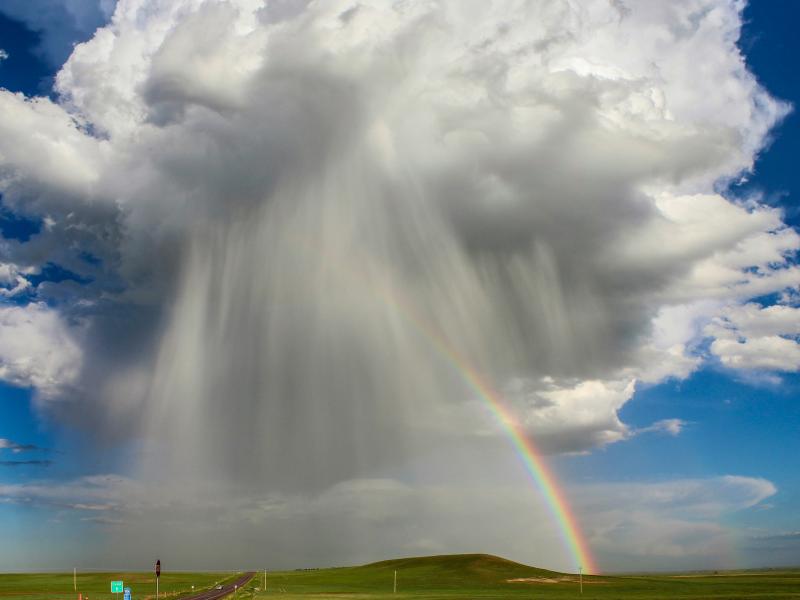
Atmospheric Aerosols
Atmospheric Aerosols
Small particles with large impacts
Small particles with large impacts
Atmospheric aerosols consist of small particles of solids, like dust, and liquids, like water, suspended in the atmosphere. Atmospheric aerosols can be either emitted directly into the atmosphere as a particle, like ash, or form when emitted gases undergo complex chemical reactions and condense as particles. Aerosols also have a wide range of sources and can be further classified as natural or anthropogenic, which originate from human-related activities. There are many different types of natural aerosols, including dust, sea-salt, smoke, and those from living sources, referred to as biogenic aerosols.
Atmospheric aerosols range in size from a few nanometers—the size of a DNA molecule—to tens of microns—the width of a human hair—in diameter. The size of a particle alters its behavior, including how long it remains suspended in the air. Aerosol systems are complex, undergoing chemical reactions that can cause the aerosols to evaporate and recondense. This complexity makes it challenging to predict and model aerosol properties.
Why Understanding Atmospheric Aerosols Matters
Atmospheric aerosols play a significant role in Earth’s climate. Depending on their composition, they may either absorb or reflect heat and sunlight. They also form necessary seeds for cloud formation. In many climate models, the uncertainty around atmospheric aerosols and their interaction with clouds remains one of the largest overall sources of uncertainty in climate projections.
Atmospheric aerosols affect air quality and have consequences for human health. Directly measuring the amount and type of aerosols in a specific region can provide insight into how factors like pollution and wildfires influence air quality. Measurements of aerosol types can help researchers identify the sources of unknown aerosols and determine how they form.
Atmospheric Aerosol Research at Pacific Northwest National Laboratory
Pacific Northwest National Laboratory (PNNL) scientists are actively working toward developing a comprehensive understanding of atmospheric aerosols. Their research includes creating and improving aerosol models, measuring the atmosphere to determine how aerosols behave in different areas of the globe, and mimicking aerosol formation, growth, and evaporation processes in a controlled laboratory environment.
More accurately representing atmospheric aerosols is important for modeling applications ranging from determining how thunderstorms behave to assessing the Earth’s energy budget in a changing climate. PNNL researchers have active roles in developing and implementing aerosol models for projects over a range of scales. Using PNNL’s expertise in modeling Earth systems, scientists are working to better model aerosols and aerosol-cloud interactions in Earth system models through the Energy Exascale Earth System Model and Enabling Aerosol-cloud interactions at GLobal convection-permitting scalES (EAGLES) projects. PNNL researchers have also worked to enhance aerosol representation in regional models, like the Weather Research and Forecasting Model (WRF).
PNNL staff are deeply involved in field campaigns through the U.S. Department of Energy’s Atmospheric Radiation Measurement (ARM) user facility. In these campaigns, researchers use ground- and aircraft-based equipment to collect atmospheric data, including the amount and type of aerosols present. Data from the Amazon, the U.S. Great Plains, and the Azores, for example, have helped identify the sources of different types of aerosols. This research provides an important baseline because the Amazon and Azores are relatively isolated locations with minimal human-influenced aerosols, that can be compared to measurements made in more polluted locations.
Atmospheric aerosol research at PNNL benefits from the Atmospheric Measurements Laboratory (AML) located on the Richland campus. The AML has an atmospheric research chamber that enables scientists to simulate atmospheric conditions in a controlled environment. This facilitates studies of how volatile organic gases form aerosol particles and how those aerosols change over time. The AML also contains an ice nucleation chamber capable of mimicking how aerosols become seeds for clouds. These experimental capabilities provide data that lead to enhanced understanding of aerosol processes.
The combination of these three classes of expertise and capabilities allows PNNL researchers to work on large, multifaceted projects. The Integrated Cloud, Land-Surface, and Aerosol System Study (ICLASS) focuses on understanding and modeling interactions between clouds, aerosols, and land. Such an undertaking requires data from field campaigns, facilities for laboratory experiments, and expertise in developing and analyzing models.




